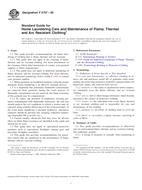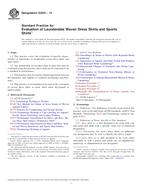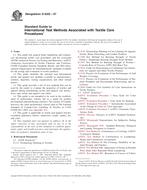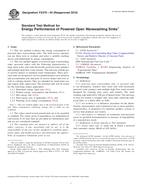We need your consent to use the individual data so that you can see information about your interests, among other things. Click "OK" to give your consent.
ASTM F2757-09
Standard Guide for Home Laundering Care and Maintenance of Flame, Thermal and Arc Resistant Clothing
STANDARD published on 1.9.2009
The information about the standard:
Designation standards: ASTM F2757-09
Note: WITHDRAWN
Publication date standards: 1.9.2009
SKU: NS-54485
The number of pages: 3
Approximate weight : 9 g (0.02 lbs)
Country: American technical standard
Category: Technical standards ASTM
The category - similar standards:
Annotation of standard text ASTM F2757-09 :
Keywords:
ICS Number Code 97.060 (Laundry appliances)
Additional information
| Significance and Use | ||||||
|
This guide is intended for use by employees of the end user, such as safety personnel or program administrators, who have chosen to implement a home laundered flame, thermal or arc resistant clothing program. This guide describes the key components involved in the home care and maintenance of flame, thermal, and arc resistant clothing. The decision to home launder flame, thermal and arc resistant clothing is part of an overall hazard analysis. It should include the nature of the hazard, the soils and any chemicals present in the workplace. Requirements may exist that require work apparel to be cleaned professionally due to the risk of contamination of the home or waste water caused by the wearer’s on the job exposure. The guide provides the end user assistance to develop laundering methods that will clean the garment and maintain the flame, thermal, and arc resistant characteristics of the clothing during its useful service life. The guide also provides suggestions for increasing the wear life, appearance and function of the clothing. The guide also provides suggestions as to when flame, thermal, and arc resistant garments should be removed from service. |
||||||
| 1. Scope | ||||||
|
1.1 This guide provides recommendations for home laundering of clothing that is flame, thermal, and arc resistant. 1.1.1 This guide does not apply to dry cleaning of flame, thermal, and arc resistant clothing. For more information on dry cleaning, follow label instructions or contact your garment supplier or fabric manufacturer. 1.1.2 This guide does not apply to industrial laundering of flame, thermal, and arc resistant clothing. For more information on industrial laundering, follow Guide F 1449 or contact your garment supplier. 1.2 When garments are laundered properly, using the proper detergent, home laundering is an effective cleaning process. 1.3 It is important that potentially flammable contaminants are removed from garments during the wash process. If flammable contaminants are not removed, the flame resistance of the garment may be compromised. 1.3.1 To reduce the potential of employees wearing garments contaminated with flammable substances, the end user should analyze the soil conditions to which a worker may be exposed, along with the effectiveness of the wash procedure. In the event home laundering is deemed ineffective, alternative solutions should be pursued (dry cleaning, industrial laundering, disposable FR coveralls, etc.). 1.4 Certain laundry chemicals that may have an adverse effect on fabric flame resistance are identified in this guide and should not be used. 1.5 This guide does not apply to specialized protective garments such as specialized firefighter turnout gear and proximity firefighter ensembles. 1.6 This guide also provides recommendations for inspection criteria that are significant to the performance of flame, thermal, and arc resistant clothing. |
||||||
| 2. Referenced Documents | ||||||
|
Similar standards:
Historical
1.7.2012
Historical
1.2.2014
Historical
1.1.2007
Historical
1.8.2013
Historical
1.3.2010
We recommend:
Technical standards updating
Do you want to make sure you use only the valid technical standards?
We can offer you a solution which will provide you a monthly overview concerning the updating of standards which you use.
Would you like to know more? Look at this page.



 ASTM D235-02(2012)..
ASTM D235-02(2012).. ASTM D4231-14
ASTM D4231-14 ASTM D6322-07
ASTM D6322-07 ASTM D7841-13
ASTM D7841-13 ASTM F2379-04(2010)..
ASTM F2379-04(2010)..
 Cookies
Cookies
